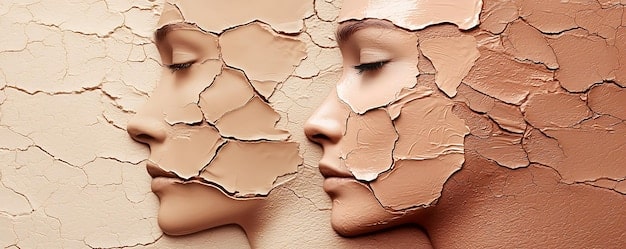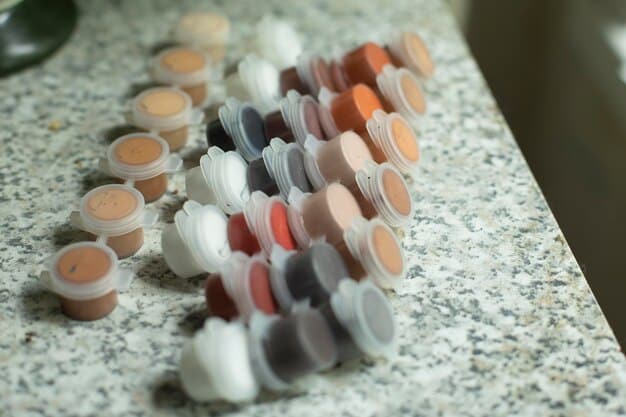The Ultimate Guide to Foundation: Choosing the Right One for Your Skin

Choosing the right foundation involves understanding your skin type, identifying your undertones, and selecting a formula and shade that perfectly match, ensuring a flawless and natural-looking complexion.
Finding the perfect foundation can feel like searching for a needle in a haystack. The Ultimate Guide to Choosing the Right Foundation for Your Skin Type (with Shade Matching Tips) is here to help you navigate the world of makeup and achieve a flawless, natural-looking complexion.
Understanding Your Skin Type
Before diving into the world of foundations, it’s crucial to understand your skin type. Knowing whether you have oily, dry, combination, or sensitive skin will significantly impact the type of foundation that works best for you. Each skin type has unique needs that specific formulas can address.
Oily Skin
Oily skin is characterized by excess sebum production, leading to a shiny appearance and a higher likelihood of breakouts. The right foundation for oily skin should control shine without clogging pores.
Dry Skin
Dry skin lacks moisture and can often feel tight or flaky. Foundations for dry skin should provide hydration and a dewy finish to prevent further dryness.
- Opt for oil-free, matte foundations.
- Look for foundations labeled as non-comedogenic.
- Consider powder foundations for maximum oil absorption.
Combination Skin
Combination skin exhibits both oily and dry areas, typically with an oily T-zone (forehead, nose, and chin) and dry cheeks. The best foundation for combination skin balances moisture and oil control.
Choose hydrating foundations with added moisturizers.
Look for foundations that contain hyaluronic acid or glycerin.

Choosing the Right Foundation Formula
Once you’ve identified your skin type, the next step is to select the right foundation formula. Foundations come in various forms, each with its own set of advantages and disadvantages. Here’s a rundown of the most common types.
Liquid Foundations
Liquid foundations are versatile and can be formulated for various skin types. They offer buildable coverage and a natural finish, making them a popular choice.
Powder Foundations
Powder foundations are ideal for oily skin as they absorb excess oil and provide a matte finish. They can be used alone or as a setting powder over liquid foundation.
Look for lightweight, breathable formulations.
Consider foundations with a satin or natural finish.
Cream Foundations
Cream foundations offer rich hydration and are perfect for dry or mature skin. They provide medium to full coverage and a dewy finish.
- Opt for hydrating formulas with antioxidants.
- Choose foundations that offer buildable coverage.
- Consider using a damp sponge for application.
Tinted Moisturizers
Tinted moisturizers provide light coverage and are great for those with normal to dry skin looking for a natural, no-makeup look. They offer minimal coverage, making them suitable for those with relatively clear skin that needs minimal correction.
BB and CC Creams
BB (Beauty Balm) and CC (Color Correcting) creams are multi-tasking products that combine the benefits of skincare and makeup. They typically offer light to medium coverage, hydration, and sun protection.

Understanding Your Skin’s Undertones
Identifying your skin’s undertone is crucial for selecting the perfect foundation shade. Undertones are the subtle hues beneath your skin’s surface and can be warm, cool, or neutral. Matching your foundation to your undertone ensures a natural and seamless blend.
Warm Undertones
Warm undertones have hints of yellow, peach, or gold. If you have warm undertones, you may notice that gold jewelry complements your skin better than silver.
Cool Undertones
Cool undertones have hints of pink, red, or blue. If you have cool undertones, silver jewelry may look more flattering on you than gold.
- Look for foundations with yellow or golden pigments.
- Consider foundations labeled as “warm” or “golden.”
- Avoid foundations that appear too pink or ashy.
Neutral Undertones
Neutral undertones have a balance of both warm and cool hues. If you have neutral undertones, you can typically wear both gold and silver jewelry without one looking significantly better than the other.
Opt for foundations with pink or reddish pigments.
Look for foundations labeled as “cool” or “pink.”
How to Determine Your Undertone
One of the easiest ways to determine your undertone is to examine the veins on your wrist. If your veins appear blue or purple, you likely have cool undertones. If they appear green, you likely have warm undertones. If you can’t tell whether they’re blue or green, you likely have neutral undertones.
- Choose foundations labeled as “neutral.”
- Look for foundations that balance both warm and cool pigments.
- Experiment with different shades to find the best match.
Shade Matching Tips and Techniques
Once you’ve identified your undertone, it’s time to find your perfect foundation shade. Shade matching can be tricky, especially since foundation shades can vary widely between brands. Here are some tips to help you find the right match.
Patch Testing
Always test foundation shades on your jawline in natural light. Apply a small amount of foundation to your jawline and blend it in. The shade that disappears into your skin is the closest match.
Consider the Season
Your skin tone may change slightly depending on the season. You may need a lighter shade in the winter and a slightly darker shade in the summer. Adjust your foundation shade as needed to match your current skin tone.
Avoid testing foundation on your hand or arm, as these areas are often a different color than your face.
Test multiple shades side by side to compare them.
Use Online Tools
Many beauty websites and apps offer virtual shade matching tools. These tools use photos or quizzes to help you find the right foundation shade based on your skin tone and undertone. While these tools aren’t always perfect, they can be a helpful starting point.
| Key Point | Brief Description |
|---|---|
| ✨ Skin Type | Identify if you have oily, dry, combination, or sensitive skin. |
| 🎨 Undertones | Determine if you have warm, cool, or neutral undertones for the perfect shade match. |
| 🧪 Formula Choice | Select a formula (liquid, powder, cream) that suits your skin type and desired coverage. |
| 💡 Patch Test | Always test foundation on your jawline in natural light for an accurate match. |
Frequently Asked Questions
▼
A well-matched foundation should blend seamlessly into your skin, disappearing without any visible lines. Test it on your jawline in natural light to ensure it’s a perfect match.
▼
Yes, mixing foundations can help you achieve your desired shade and coverage. Use a mixing palette to combine different shades until you find your perfect match.
▼
The best application method depends on the formula and your desired coverage. Sponges provide a natural look, brushes offer more coverage, and fingers work well for tinted moisturizers.
▼
Start with a primer, apply your foundation in thin layers, and set it with aTranskription: a) 2 Punkte
b) 3 Punkte
c) 4 Punkte
d) 4 Punkte
e) 8 Punkte
f) 4 Punkte
Summe: 25 Punkte





